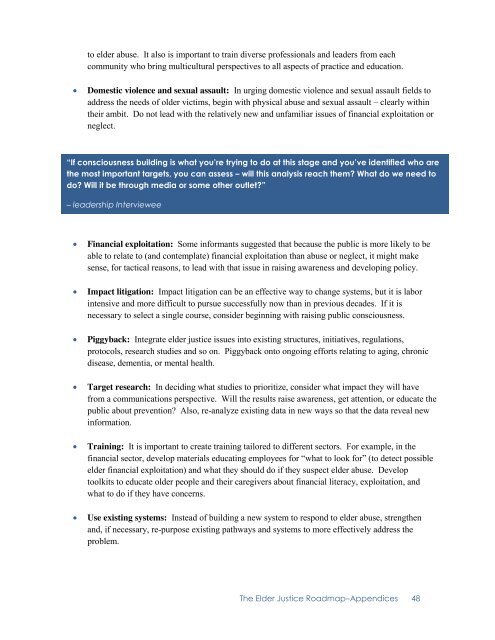The Elder Justice Roadmap
2gJRXoo
2gJRXoo
You also want an ePaper? Increase the reach of your titles
YUMPU automatically turns print PDFs into web optimized ePapers that Google loves.
to elder abuse. It also is important to train diverse professionals and leaders from each<br />
community who bring multicultural perspectives to all aspects of practice and education.<br />
<br />
Domestic violence and sexual assault: In urging domestic violence and sexual assault fields to<br />
address the needs of older victims, begin with physical abuse and sexual assault – clearly within<br />
their ambit. Do not lead with the relatively new and unfamiliar issues of financial exploitation or<br />
neglect.<br />
“If consciousness building is what you’re trying to do at this stage and you’ve identified who are<br />
the most important targets, you can assess – will this analysis reach them? What do we need to<br />
do? Will it be through media or some other outlet?”<br />
– leadership Interviewee<br />
<br />
<br />
<br />
<br />
<br />
<br />
Financial exploitation: Some informants suggested that because the public is more likely to be<br />
able to relate to (and contemplate) financial exploitation than abuse or neglect, it might make<br />
sense, for tactical reasons, to lead with that issue in raising awareness and developing policy.<br />
Impact litigation: Impact litigation can be an effective way to change systems, but it is labor<br />
intensive and more difficult to pursue successfully now than in previous decades. If it is<br />
necessary to select a single course, consider beginning with raising public consciousness.<br />
Piggyback: Integrate elder justice issues into existing structures, initiatives, regulations,<br />
protocols, research studies and so on. Piggyback onto ongoing efforts relating to aging, chronic<br />
disease, dementia, or mental health.<br />
Target research: In deciding what studies to prioritize, consider what impact they will have<br />
from a communications perspective. Will the results raise awareness, get attention, or educate the<br />
public about prevention? Also, re-analyze existing data in new ways so that the data reveal new<br />
information.<br />
Training: It is important to create training tailored to different sectors. For example, in the<br />
financial sector, develop materials educating employees for “what to look for” (to detect possible<br />
elder financial exploitation) and what they should do if they suspect elder abuse. Develop<br />
toolkits to educate older people and their caregivers about financial literacy, exploitation, and<br />
what to do if they have concerns.<br />
Use existing systems: Instead of building a new system to respond to elder abuse, strengthen<br />
and, if necessary, re-purpose existing pathways and systems to more effectively address the<br />
problem.<br />
<strong>The</strong> <strong>Elder</strong> <strong>Justice</strong> <strong>Roadmap</strong>–Appendices 48


